After ranking the top-20 centres, right wingers, and left wingers in the NHL over the past three seasons, we’re moving on to ranking the total impact of defencemen relative to their peers today.
We’re actually expanding this year and doing the top 40, so today we’ll look at 40-21 with the rest to follow on Saturday. Before we get into it, you can check out 2016’s top 20 here, and 2017’s list here.
Like the previous two years, I owe a lot of thanks for this project to others in the hockey analytics field, such as Emmanuel Perry, Dom Luszczyszyn, Steve Burtch, Dominic Galamini Jr., and Tyler Dellow. Their help along the way directly and indirectly influenced this project.
Statistics for this project were collected from SPORTLOGiQ, Natural Stat Trick, Corsica, Puck IQ, Hockey Reference, the NHL’s official website, and Dom Luszczyszyn’s Game Score database.
In order to get a larger sample size to work with, this year I lowered the barrier of eligibility for the rankings from 2000 5-on-5 minutes over three seasons to 2000 minutes overall. This helped include some promising young players, but there are still rookies from last year who won’t make the cut — 193 defencemen qualified for the project.
The weighting of the categories for defencemen remains the same as last season: 25 for offence, 40 for transition and 35 for defence, though there are new statistics added and the difficulty of minutes adjustment has been changed.
Previously, players could be awarded a maximum of a 25 per cent boost to their score based on the difficulty of their minutes, while this year that category was boosted to 30 per cent. The mean score for each position was taken and deducted from each individual’s difficulty score, so a player’s score could be boosted or knocked down depending on the difficulty of the minutes they were assigned. The difficulty adjustment is already applied to the numbers shown and on the graphics.
Each season was weighted so that recent years account for more of a player’s total score, with 22.2 per cent for 2015-16, 33.3 per cent for 2016-17, and 44.5 per cent for 2017-18. If a player only played in two of those years they would see a weighting of 42.8 per cent for 2016-17, and 57.8 per cent for 2017-18.
[snippet id=4234155]
Here are the statistics used in each category:
Offence: 5-on-5 and power play goals, primary assists, secondary assists, high danger scoring chances, scoring chances, passes to the slot, scoring chances off the rush, passes off the rush, offensive zone passes, rebound recoveries, scoring chance generating plays, shot attempts, penalties drawn, on-ice goals for relative to teammates (all per 60 minutes), and offensive zone pass completion rate.
Transition: 5-on-5 outlet passes, stretch passes, controlled carries out of the defensive zone, neutral zone passes forward and east-west, controlled entries into the offensive zone (all per 60 minutes), Corsi for percentage, Corsi for percentage relative to teammates, controlled exit rate relative to teammates, controlled entry rate relative to teammates, outlet, stretch, and neutral zone pass completion rates relative to teammates.
Defence: 5-on-5 and shorthanded loose puck recoveries by zone, defensive zone non-dump in loose puck recoveries, blocked passes, stick checks, body checks, blocked shots, puck battles won, puck battles won percentage, controlled entries against, odd-man rushes against, total zone clearances, penalties taken, on-ice goals against relative to teammates, on-ice shot attempts against relative to teammates, on-ice passes to the slot against relative to teammates, on-ice high danger chances against relative to teammates (all per 60 minutes), turnover rate by zone relative to teammates.
Degree of difficulty: Puck IQ’s competition faced percentages (2016-17 only), Game Score’s quality of forwards faced, Game Score’s quality of defencemen faced, Game Score’s quality of teammate forwards, Game Score’s quality of teammate defencemen, Corsi quality of competition, Corsi quality of teammates, time on ice quality of competition, time on ice quality of teammates, personal shooting percentage relative to career average, on-ice shooting percentage, on-ice save percentage, defensive zone starts percentage, 5-on-5 ice time, and overall ice time per game.
There’s a slight change to the charts this year as well, as I’ll be showing how players rank both in percentile form — a straight up ‘what percentage of their peers are they ahead of” — and also the percentage that the player impacts a category compared to the best player at their position, which I’m calling per cent of peak. For example Josh Manson’s offensive impact is 44.5 per cent of Brent Burns’.
Let’s get into it.
40. Mike Green
Difficulty adjustment: +4.51%
Offence: 12.00/25 | Transition: 25.93/40 | Defence: 16.73/35
Total: 54.30/100

At one time Green was the NHL’s best offensive defenceman and while those days are long gone, he remains an underrated top-pair blueliner with strong offensive ability. This is especially true on the power play, where he remains one of the NHL’s biggest scoring chance producers from the back end.
Green can be exposed off the rush, and is prone to quite a few turnovers, but he’s pretty strong at recovering loose pucks, which plays well into his strong transition game. He’s among the NHL leaders in carry outs and total plays that transition the puck up the ice.
39. Alexander Edler
Difficulty adjustment: +6.92%
Offence: 11.66/25 | Transition: 22.71/40 | Defence: 20.30/35
Total: 54.67/100
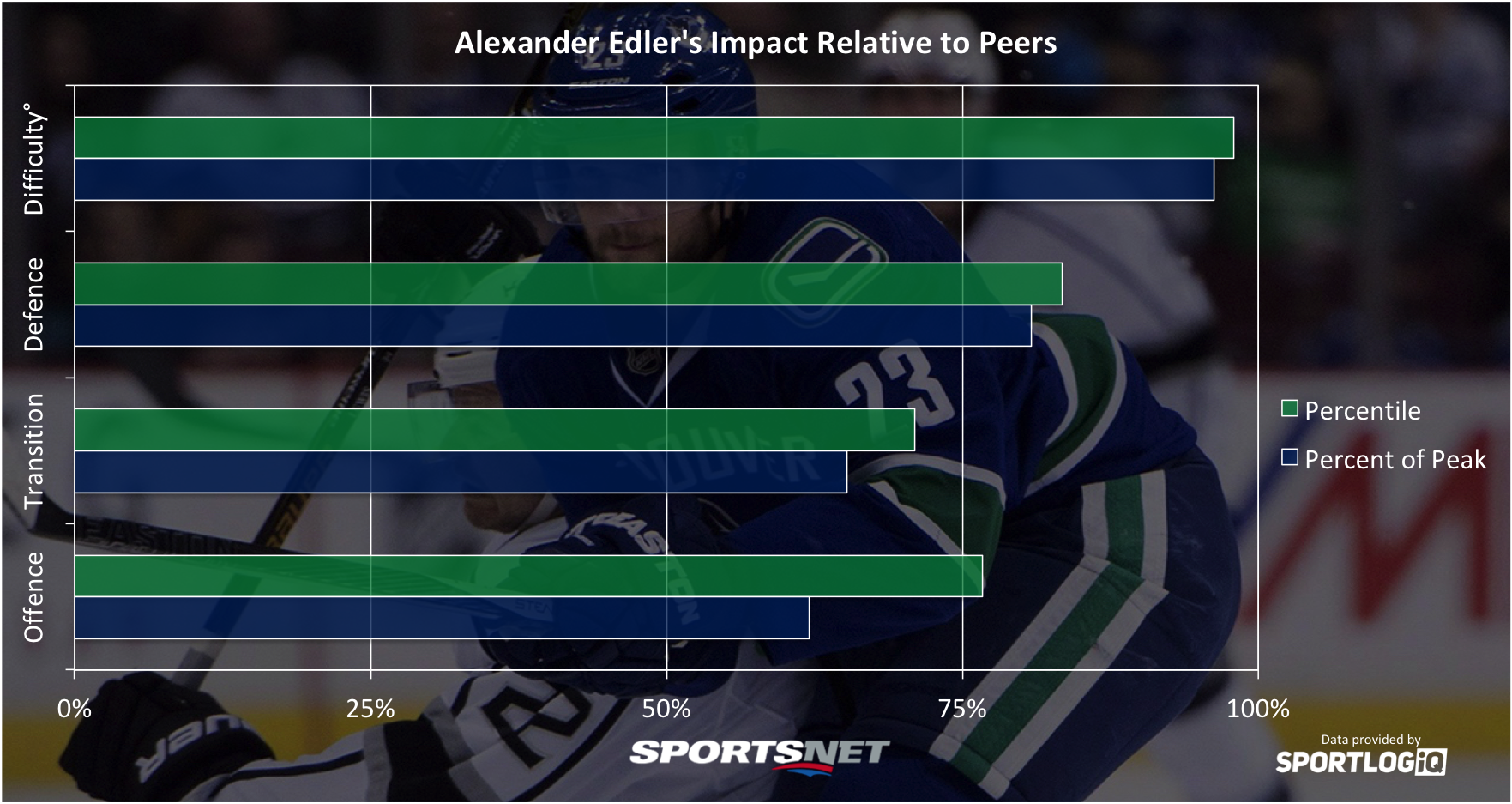
I didn’t expect Edler to be among the top defencemen in the league these days, but the brutal minutes he plays in Vancouver have hidden how strong of a player he has been over the past three seasons. Edler is no longer in his offensive prime, and his transition game is declining a bit, but he’s been very strong without the puck.
Edler is a loose puck recovery machine in the defensive zone, which works well when he’s paired with a partner who can transition well, but at this point in his career he needs some support. Over the past three seasons Edler has been a very good defenceman, but despite an uptick in offence last year his overall game is beginning to fall off.
[snippet id=3816507]
38. Ryan McDonagh
Difficulty adjustment: +5.17%
Offence: 13.57/25 | Transition: 21.63/40 | Defence: 19.48/35
Total: 54.68/100
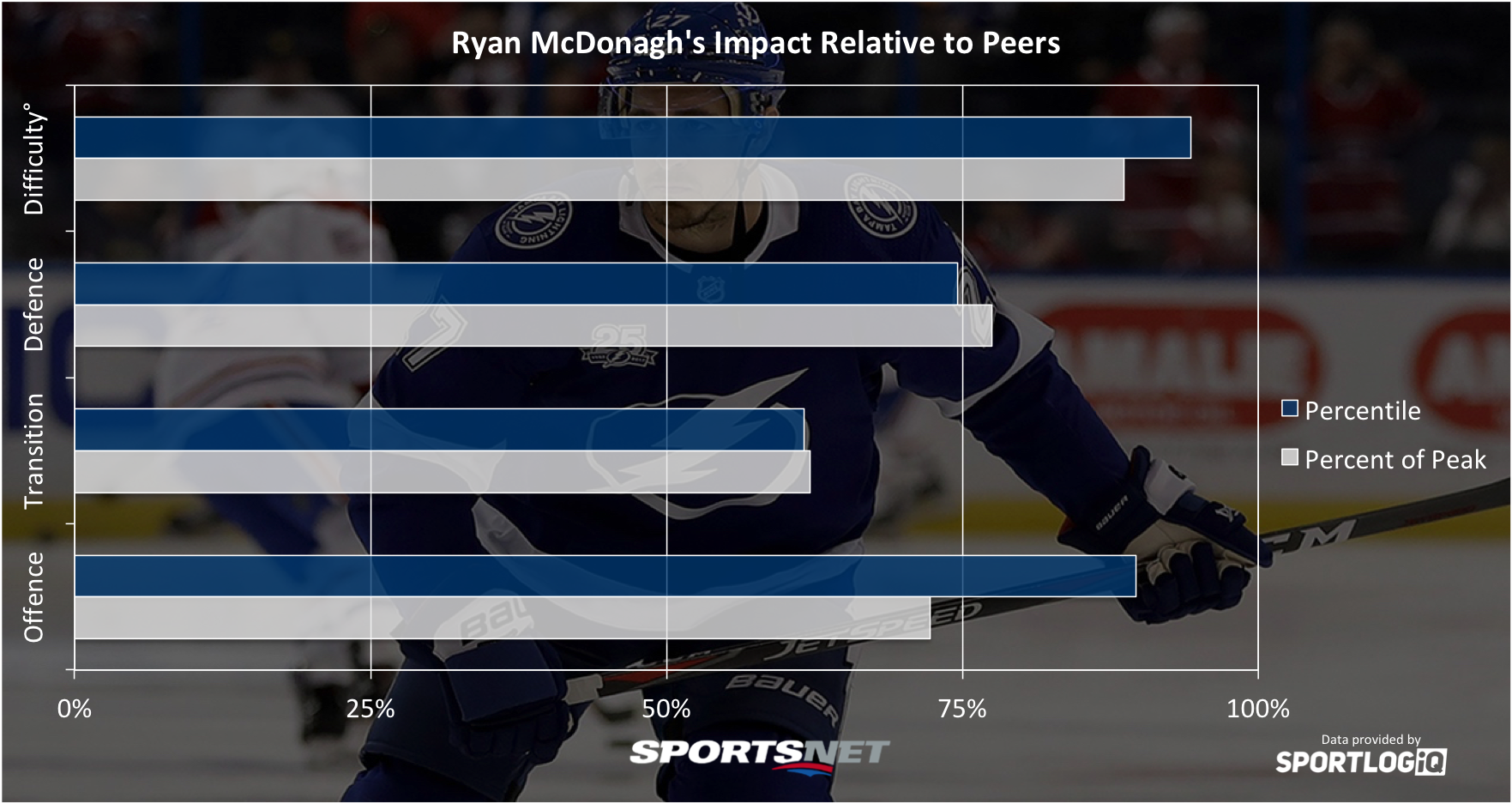
A consistent defensive presence, McDonagh has been a strong player in the offensive zone, too, but has historically struggled moving the puck through the neutral zone. Last season, however, McDonagh pushed himself a bit more and made significant improvements in his passing game, moving the puck up more often and more successfully than recent seasons.
His offensive game mostly revolves around playmaking on the power play, but in Tampa Bay he may not get much of a chance to produce there. If he wants to be an offensive contributor, he’s going to have to get a bit more creative at even strength.
37. Colin Miller
Difficulty adjustment: -2.19%
Offence: 12.43/25 | Transition: 24.40/40 | Defence: 17.88/35
Total: 54.72/100
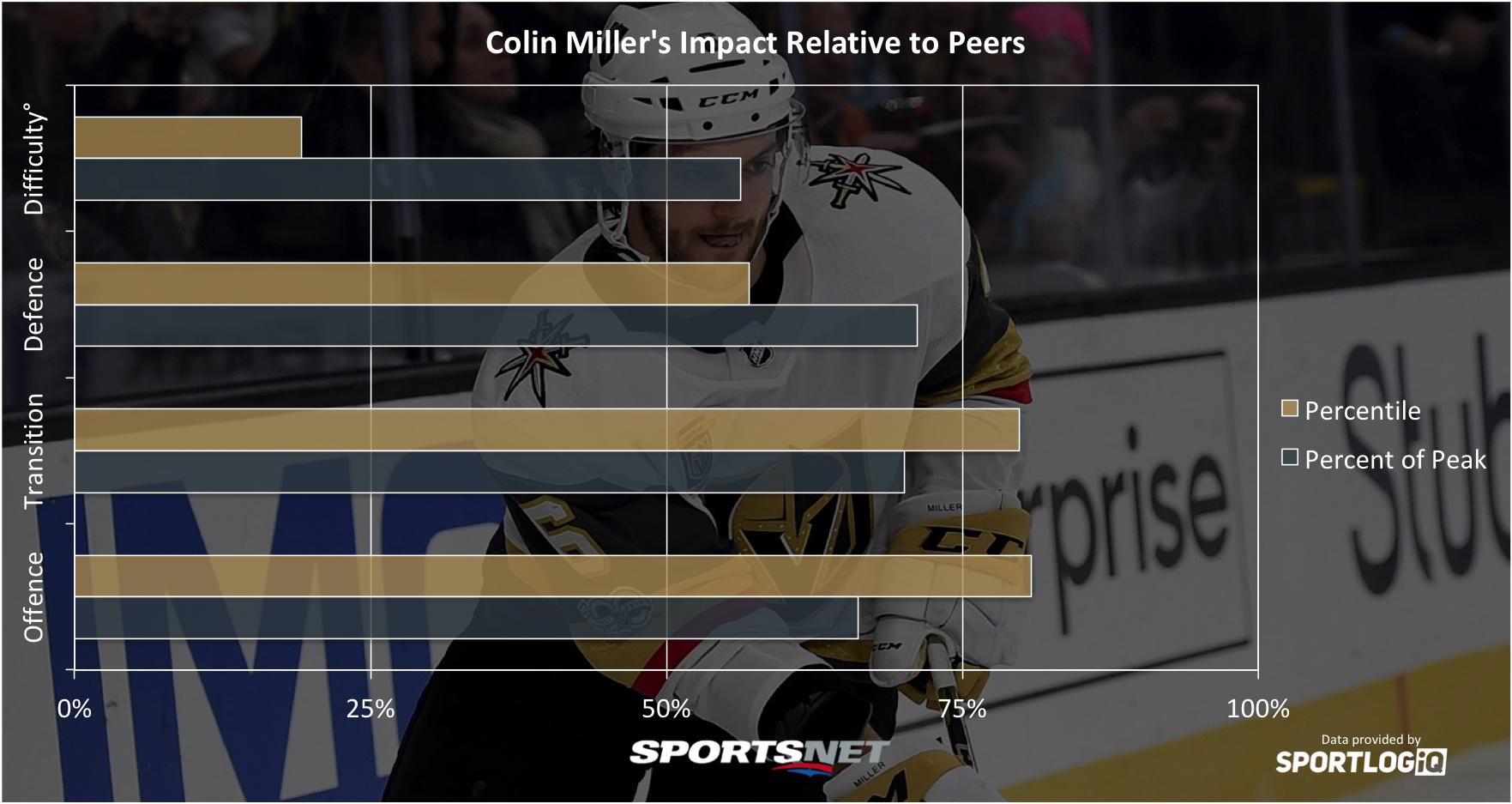
Miller has developed into an excellent puck moving defenceman the past two seasons, though there’s no doubt some of this success is due to the extreme sheltered opportunities he has received in his career. Two seasons worth of solid underlying numbers in Boston lead to a breakout year offensively for the Golden Knights.
Offensively Miller particularly excelled on the power play, and he was one of the better defencemen at creating them by drawing calls with his strong transition play. One reason why multiple coaches may have decided to shelter Miller is he has one of the lowest puck battle win rates among all defencemen, though he kind of makes up for it with being a strong zone entry denier. It would be interesting to see what he could do in tougher minutes, and with Nate Schmidt suspended, we might see it this year.
36. Chris Tanev
Difficulty adjustment: +4.61%
Offence: 7.43/25 | Transition: 25.98/40 | Defence: 21.69/35
Total: 55.10/100

Tanev is well known around the league for being an excellent defensive player. He plays though minutes against opposing top lines on a weak team, which is a thankless job at times. But what’s rarely mentioned is that he’s almost as strong at moving the puck up the ice in transition.
This is a somewhat rare quality for the so-called “defensive defenceman” but in my opinion is key to that player type being effective in the modern game. There are some bona fide excellent defensive players in the NHL who win pucks like crazy, but become a liability as soon as they get it. Tanev isn’t that, which makes him a very valuable player despite not really moving the needle offensively.
35. Jake Muzzin
Difficulty adjustment: +1.89%
Offence: 12.02/25 | Transition: 23.74/40 | Defence: 19.56/35
Total: 55.33/100
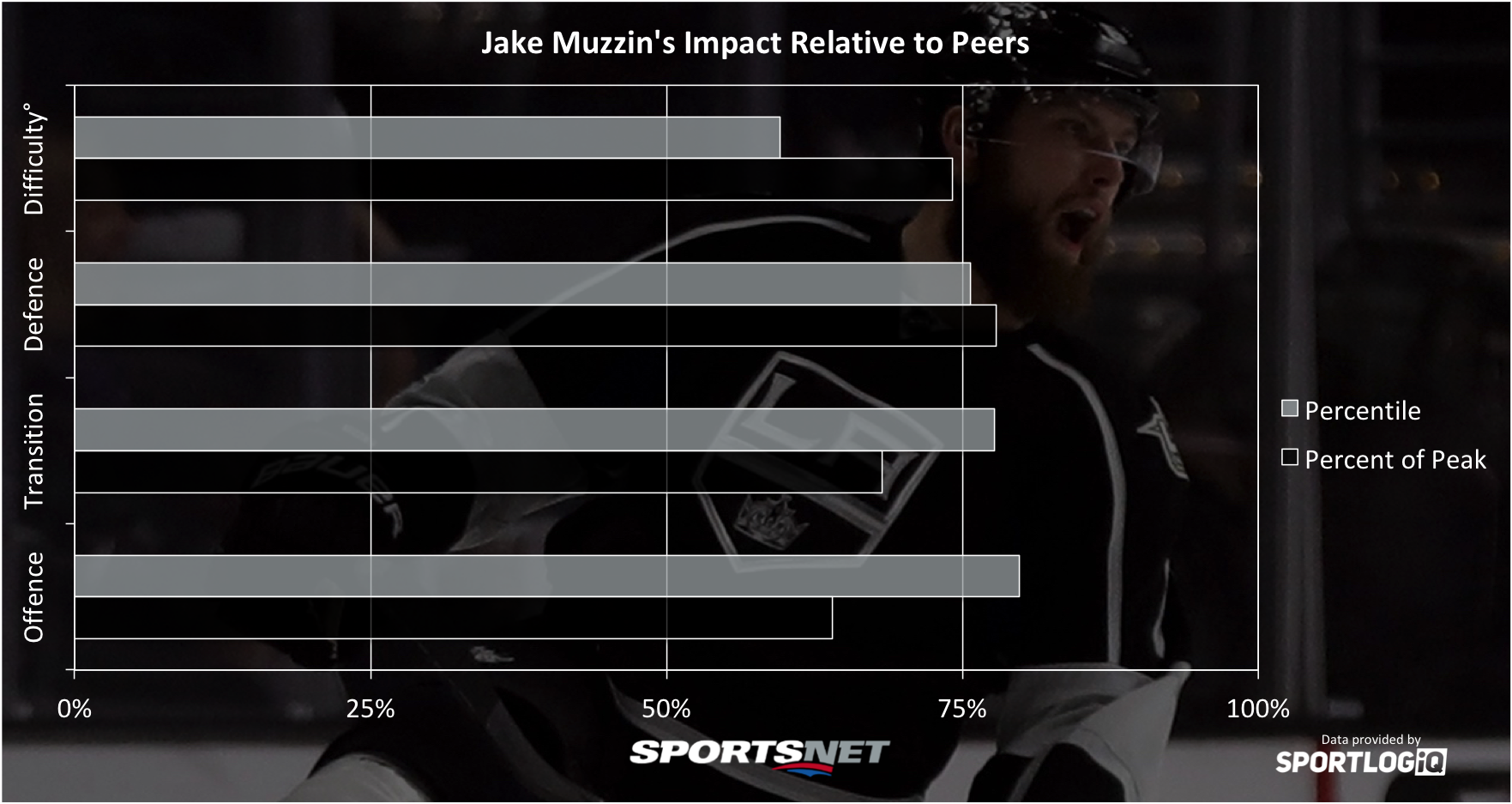
Muzzin has certainly been helped in his career by playing a ton of minutes with Drew Doughty, but he’s a very well-balanced player who can fit in wherever the Kings need him.
Last season was a bit of a bounce back for Muzzin, who put up a bunch of primary points on the power play. He also considerably improved his transition play by exiting the defensive zone with control more often and making more neutral zone passes with better accuracy.
34. Oscar Klefbom
Difficulty adjustment: +3.83%
Offence: 11.82/25 | Transition: 23.54/40 | Defence: 19.97/35
Total: 55.33/100
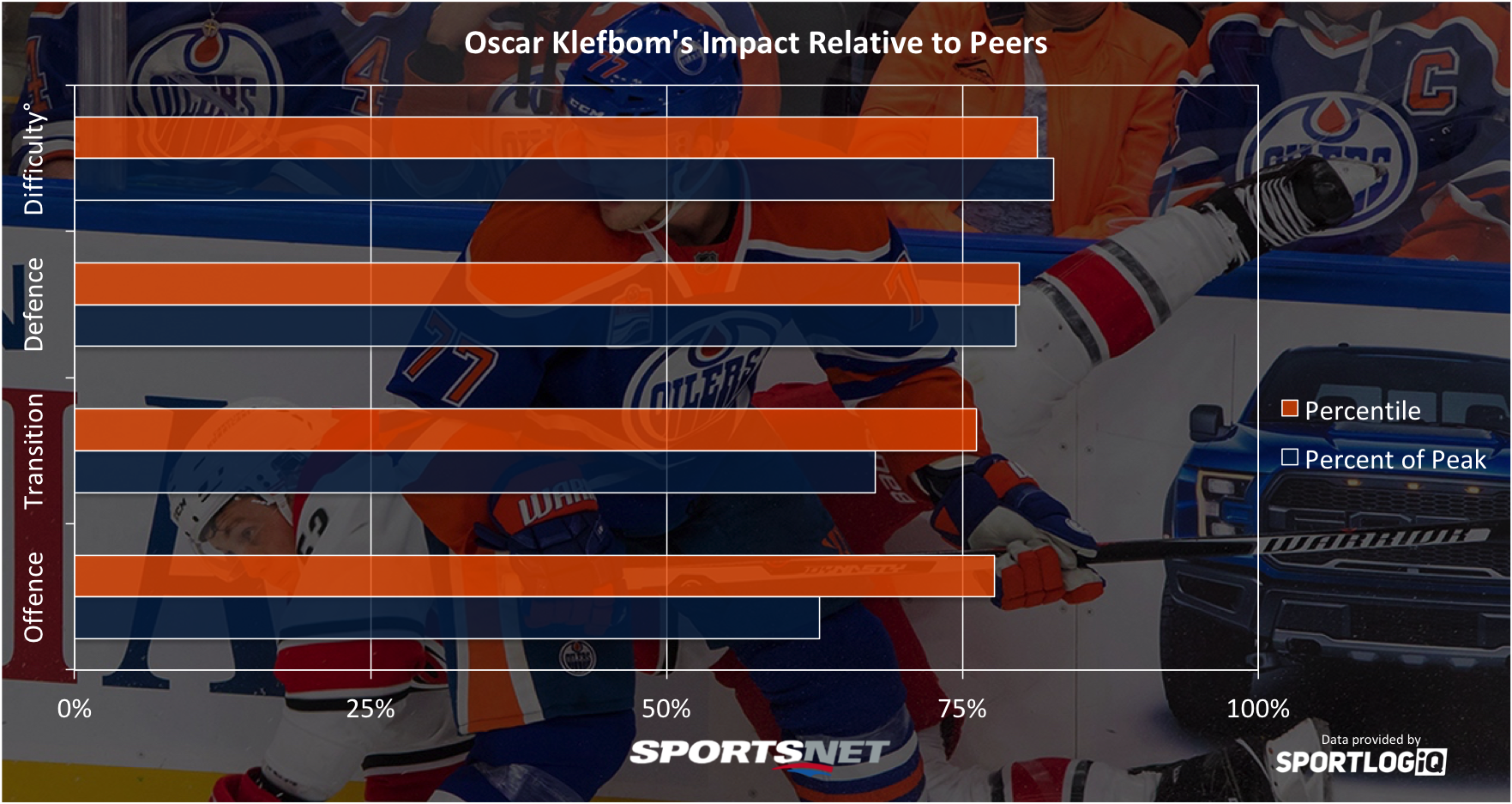
After a breakout season in 2016-17, Klefbom struggled with injuries last year and took a lot of flak for the Oilers’ poor play, but overall he was still a very impactful player in all three zones. For three seasons Klefbom has been a consistently strong transition player who is excellent on the breakout and one of the stronger defensive zone passers in the game.
Unfortunately for Klefbom, the other areas of his game can go up and down, and there was good reason to get on him for his defensive play last season. He’s strong recovering pucks in the defensive zone, but his neutral zone defence leaves a lot to be desired, and he has a pretty high turnover rate to boot. One plus in his game is that he doesn’t put his team down a man very often.
33. Brett Pesce
Difficulty adjustment: +1.87%
Offence: 9.47/25 | Transition: 25.14/40 | Defence: 20.95/35
Total: 55.56/100
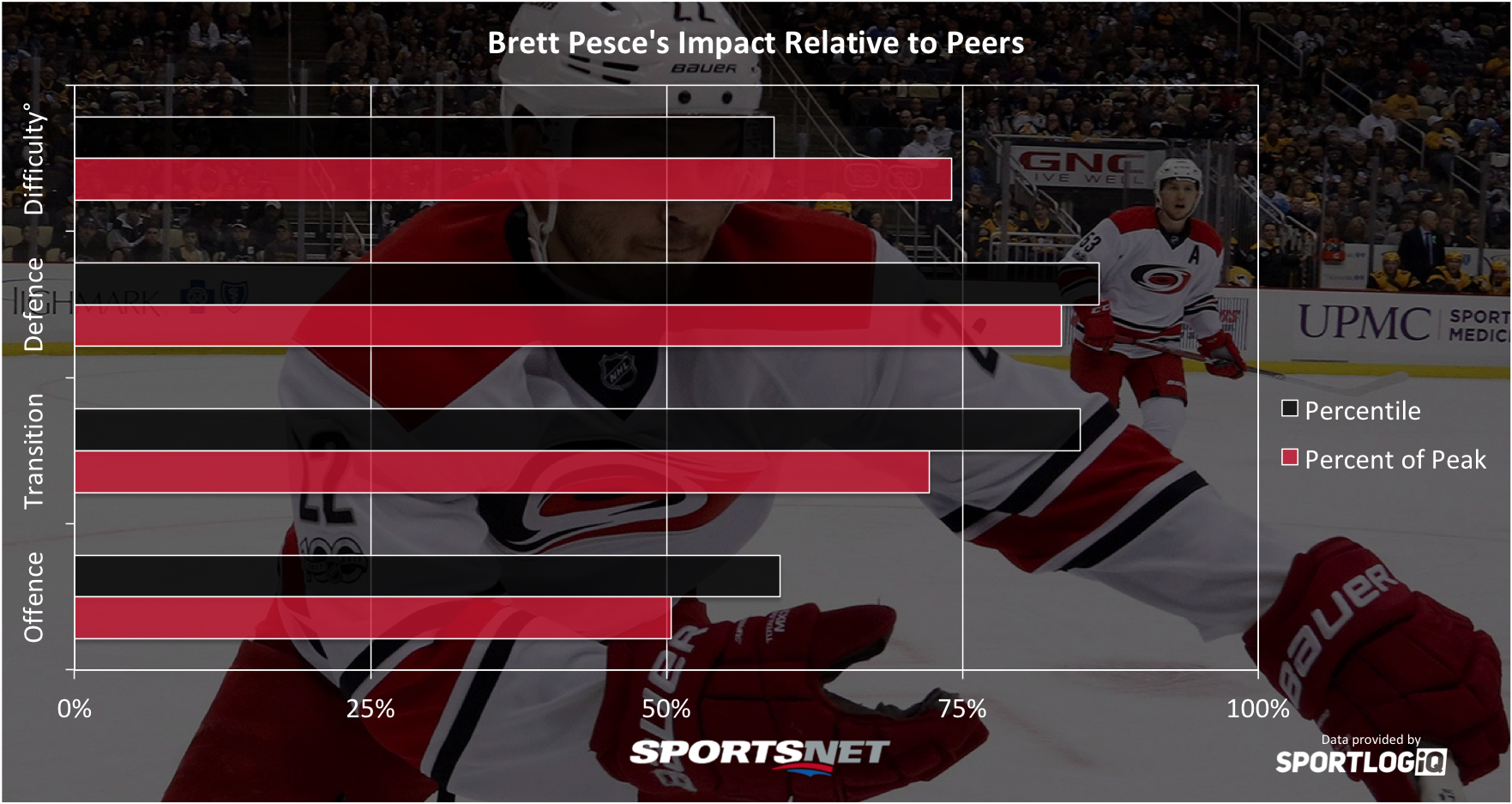
Pesce is part of a new breed of defensive defencemen who do more than just defend and clear the puck off the glass. He’s never going to be an offensive powerhouse, but he’s a strong passer in the offensive zone and can help support his teammates who actually get the scoring done.
Pesce is brilliant without the puck and is one of the NHL’s most effective puck battlers and tenacious man-on-man defenders. He’s also excellent at denying controlled entries. And somehow, despite engaging defensively more often than others at his position, he does a great job staying out of the box. He’s a heck of a player, even though you don’t often hear his name.
32. T.J. Brodie
Difficulty adjustment: +3.36%
Offence: 9.62/25 | Transition: 24.83/40 | 21.40/35
Total: 55.86/100
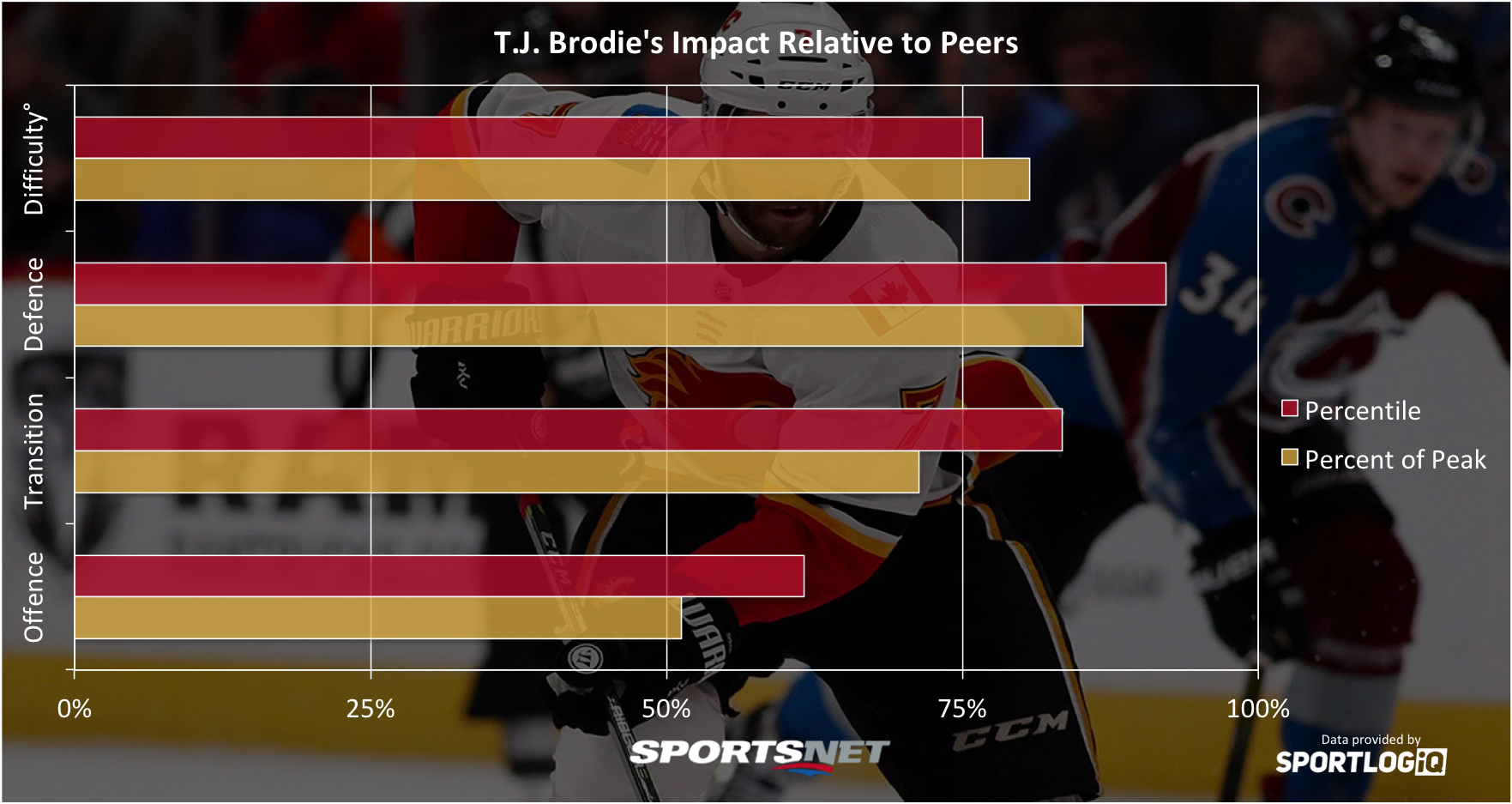
After being separated from Mark Giordano a couple years ago, Brodie has seen a slight decline in his offensive numbers, but the main change that everyone seems to notice is the big drop in plus/minus. I’m not a big fan of that statistic, especially when you use it as a defensive stat, and when you break down Brodie’s play it’s easy to see why.
Brodie is an excellent puck retriever in every zone, and a strong puck battler when those loose pucks are contested — he excels at removing possession from opponents all over the ice. In transition he’s a fantastic zone exit option and strong neutral zone passer, but last season he was pretty turnover happy in his own zone. Back at Giordano’s side this year, it’ll be interesting to see if Brodie rebounds.
31. Ivan Provorov
Difficulty adjustment: +3.55%
Offence: 13.37/25 | Transition: 24.44/40 | Defence: 18.13/35
Total: 55.94/100
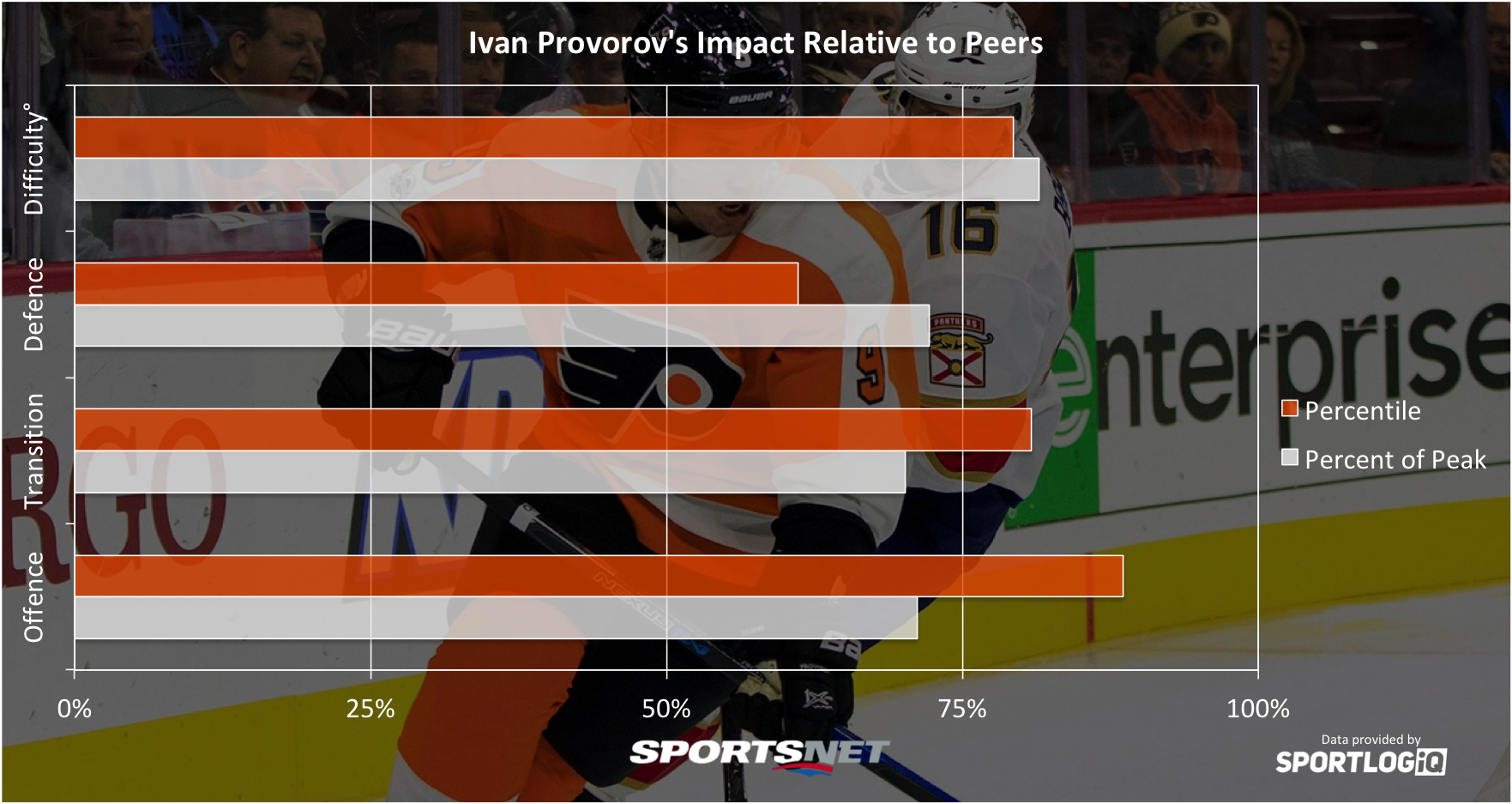
Provorov had a breakout goal scoring season in 2017-18 with 17, which is even more impressive when you realize only two came on the power play. He’s an absolute beast in the offensive zone if you give him a little space to work with, though that hasn’t translated to the power play at all where he’s been objectively bad so far in his career.
Strangely, Provorov also struggles on the penalty kill, so he’s developing into a strong even strength performer who hasn’t figured out special teams yet. One of the keys to his game at even strength is an ability to carry the puck out of the defensive zone, and he’s an excellent neutral zone passer who opens up lanes for Flyers forwards to gain the offensive zone.
[relatedlinks]
30. Mattias Ekholm
Difficulty adjustment: +2.11%
Offence: 11.29/25 | Transition: 24.44/40 | Defence: 21.35/35
Total: 57.08/100
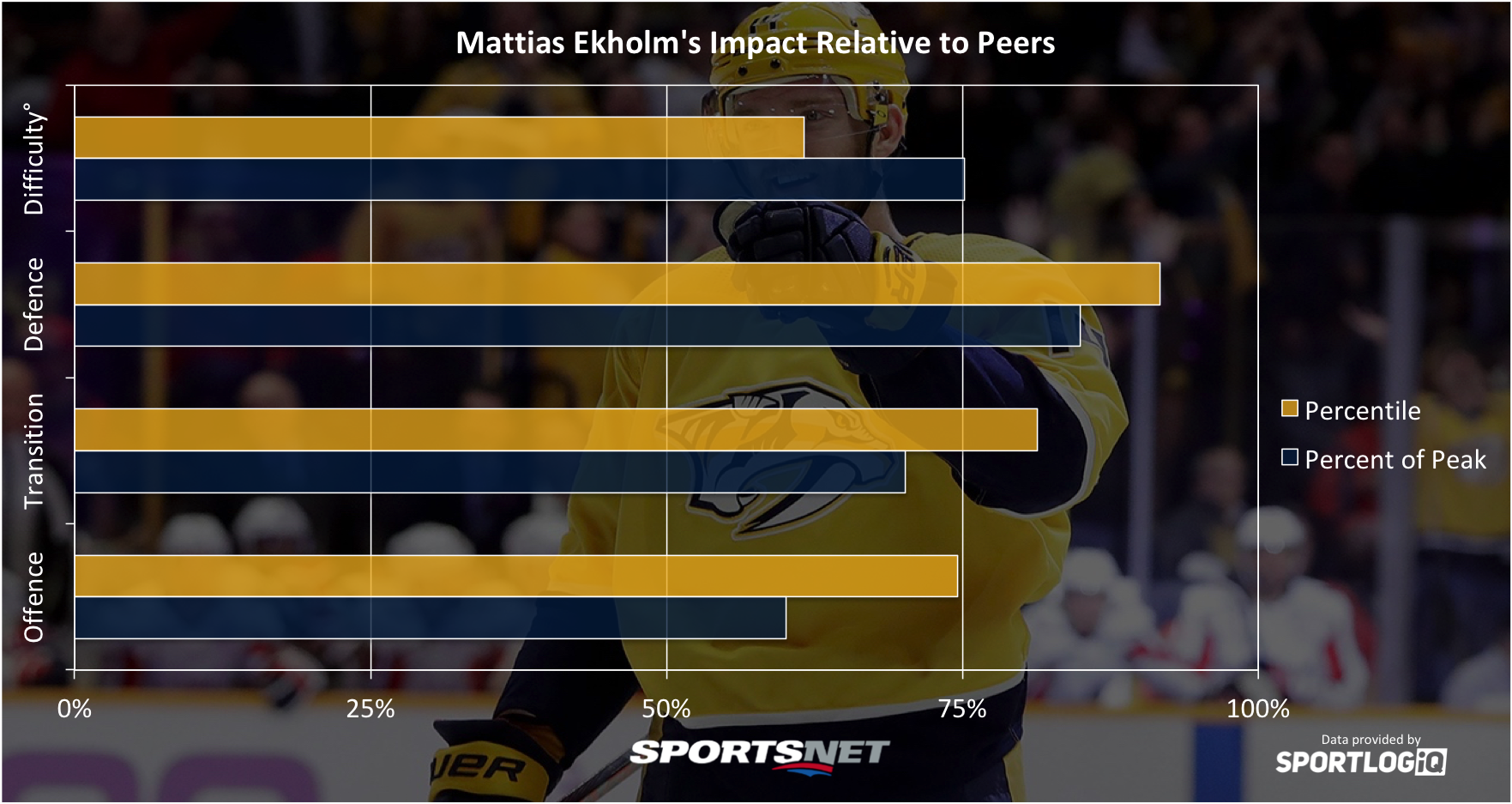
Ekholm has always been a killer defensive player with surprisingly solid transition play, but last season he started to contribute more offensively as he got an increase in power play time. Meanwhile, his confidence to use his puck skills grew.
Like most of the Predators’ defence core his defensive numbers weren’t as strong as previous seasons due to increased turnover numbers. He still maintained strong shot suppression and puck retrieval numbers, though, and is an excellent penalty killer.
29. Dmitry Orlov
Difficulty adjustment: +2.61%
Offence: 10.98/25 | Transition: 26.98/40 | Defence: 19.37/35
Total: 57.34/100
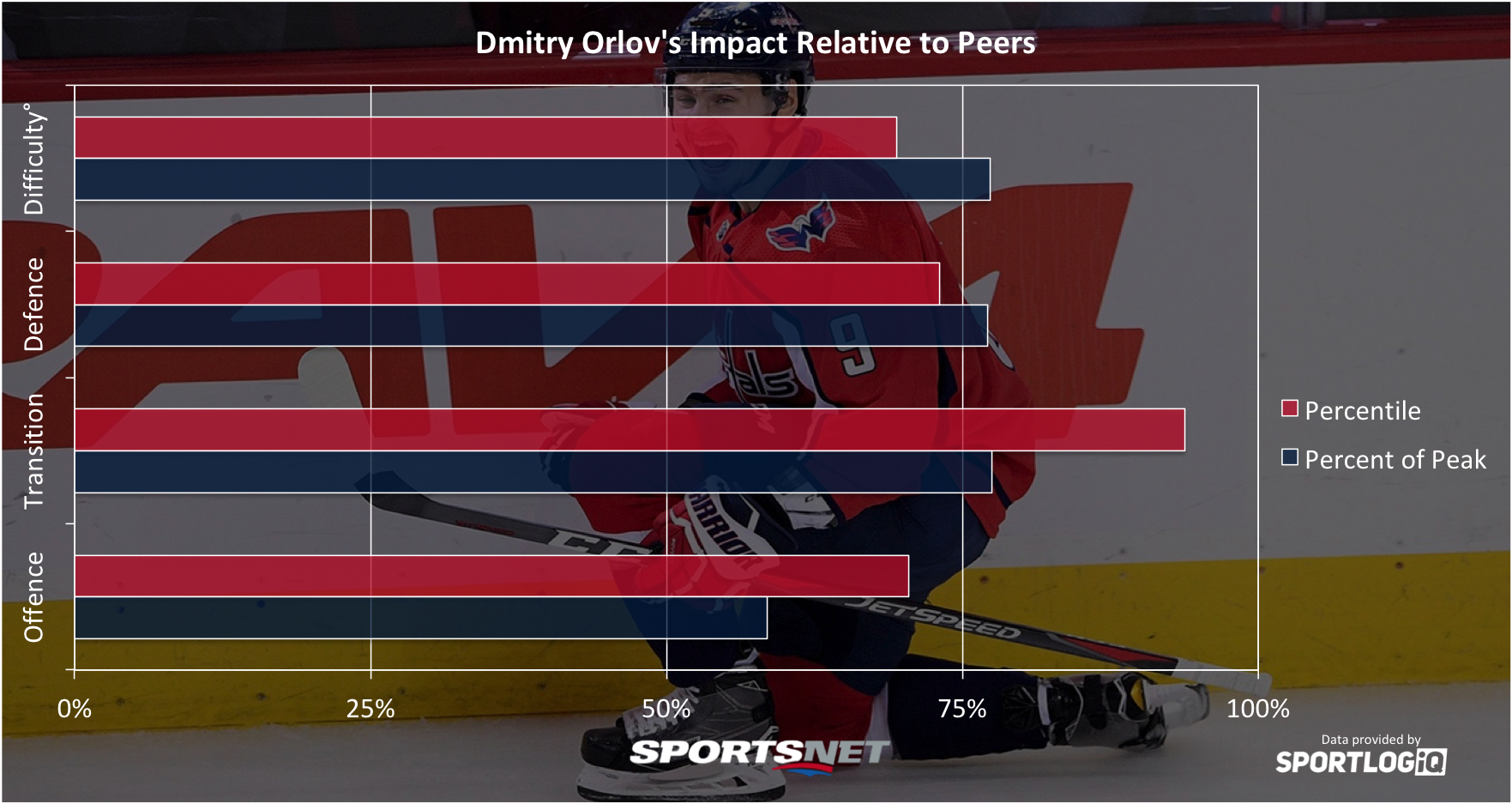
Three straight seasons of nearly identical solid, but not spectacular, offensive production conceals some real progress Orlov has made in his game. He’s gone from a sheltered and untrusted third pairing guy to a tough-minutes eater who moves the puck incredibly well.
Without the puck Orlov can still be a bit of an adventure, so he’s honed his puck management each of the past three seasons and creates very few turnovers, meaning he won’t be stuck playing reactionary hockey as often, at least due to his own mistakes.
28. Justin Faulk
Difficulty adjustment: +3.17%
Offence: 12.32/25 | Transition: 25.83/40 | Defence: 19.47/35
Total: 57.63/100

A huge drop in Faulk’s goal scoring last season took the brunt of the attention, but his defensive play also hit a big bump in the road, which lead to some trade rumours throughout the summer. But at least for now, he remains part of one of the strongest six-man defence units in recent NHL history.
Faulk’s play at both blue lines is only a little above average when scaled against his teammates in Carolina, but he truly excels at handling the puck in the neutral zone. In that tightly checked area, he’s able to make a ton of successful passes and rarely commits a turnover, which allows the Hurricanes forwards to attack the offensive zone with speed.
27. Shayne Gostisbehere
Difficulty adjustment: -0.59%
Offence: 14.83/25 | Transition: 26.28/40 | Defence: 16.56/35
Total: 57.68/100
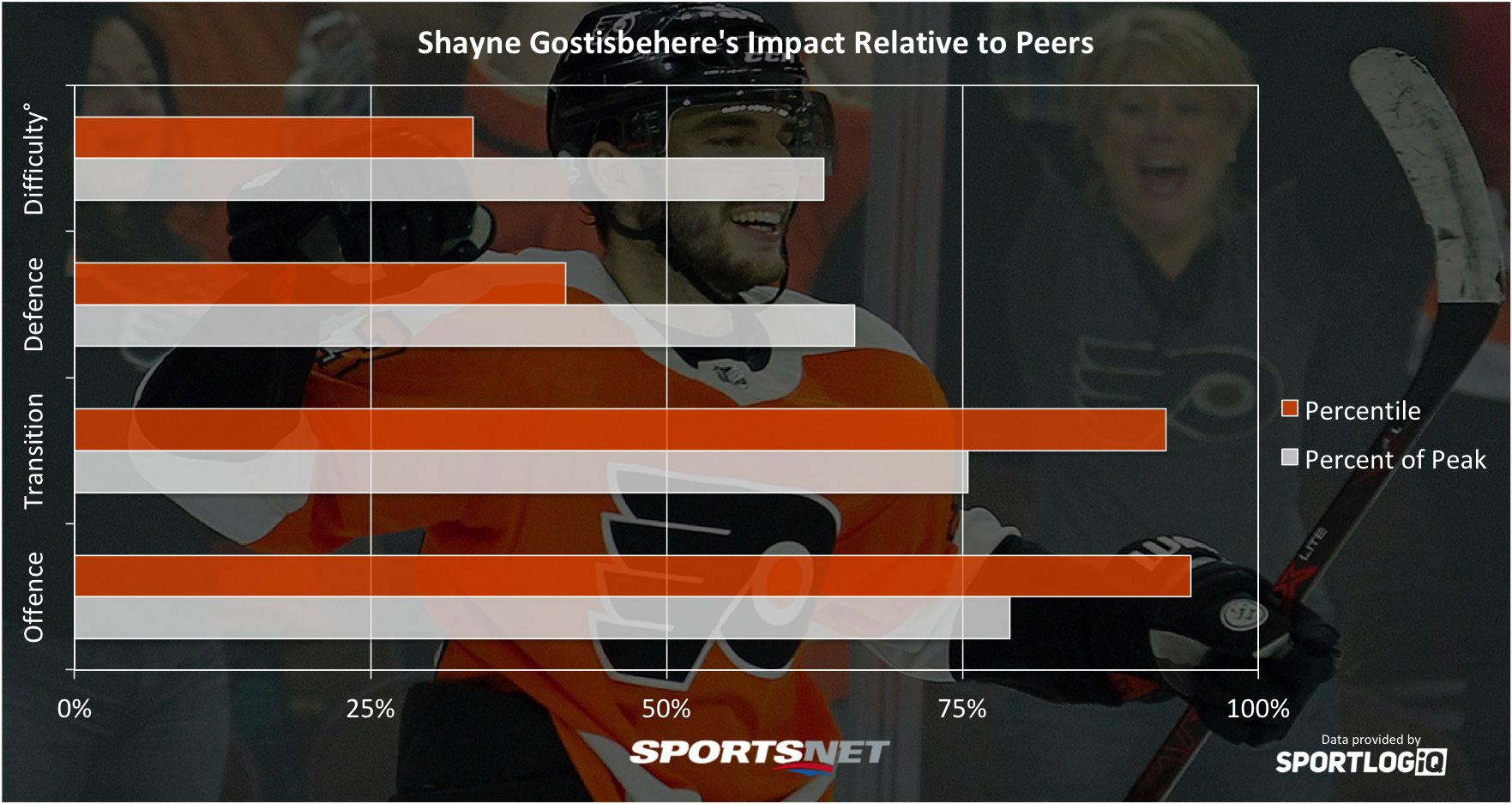
Gostisbehere is one of the NHL’s most dynamic offensive defencemen and one of the best offensive zone passers in the game. This is especially true with passes to the slot, which many defencemen struggle with — but Gostisbehere is so effective here because of his ability to pinch quickly and get back into position after letting go of the pass.
Gostisbehere is pretty sheltered, which makes sense since he’s a bit weak on defence, but he’s getting progressively tougher minutes each season. Everyone knows he’s a strong offensive player, but you don’t hear many people talk about Gostisbehere’s transition play, which has developed wonderfully. No defenceman makes more transition plays per minute than Gostisbehere and he has become a premium zone exit player who passes and skates the puck up ice with equal efficiency. His ability to take both modes of controlled transition keeps opponents on their toes, and opens up space for his teammates.
26. Torey Krug
Difficulty score: -2.06%
Offence: 14.79/25 | Transition: 25.54/40 | Defence: 17.56/35
Total: 57.90/100

Krug has become the lynchpin of the Bruins’ offensive game from the blue line in recent years and is one of the NHL’s most mobile defenders on a defensive core that lacks the quality. Charlie McAvoy helps out in that regard, but the Bruins ice a lot of battleships on the back end, with Krug as the water bug that makes the whole thing work.
His numbers took a hit this year due to the increased focus on quality of minutes played since he’s pretty aggressively sheltered, but I’m not sure that’s as necessary now as it was early in his career. Among all defencemen, only Brent Burns finds teammates in the slot as often as Krug, and his mobility with the puck at both blue lines drives a strong transition game that can get tripped up if he tries to pass too often in the neutral zone.
[snippet ID=3322139]
25. Dougie Hamilton
Difficulty adjustment: +1.63%
Offence: 15.16/25 | Transition: 24.82/40 | Defence: 18.01/35
Total: 57.99/100

Hamilton has been knocking on the door of being a top 10 NHL defenceman the past two years, but it’s that third year in 2015-16 that drags him down quite a bit. As such he ends up just outside the top 20, despite being one of the most dangerous offensive defencemen in the game who has increased his goal total every season of his career.
Hamilton’s transition game is built on a balanced approach that takes advantage of his passing and skating abilities. However, I think an argument could be made that in these rankings he benefits from playing with Mark Giordano in Calgary, who is one of the more high-event players in the NHL. Hamilton’s new team in Carolina doesn’t have a Giordano-level blueliner on the roster, but they’re stacked at the position, so I don’t expect to see any step down from Hamilton.
24. Jaccob Slavin
Difficulty adjustment: +3.29%
Offence: 11.18/25 | Transition: 25.78/40 | Defence: 21.24/35
Transition: 58.20/100
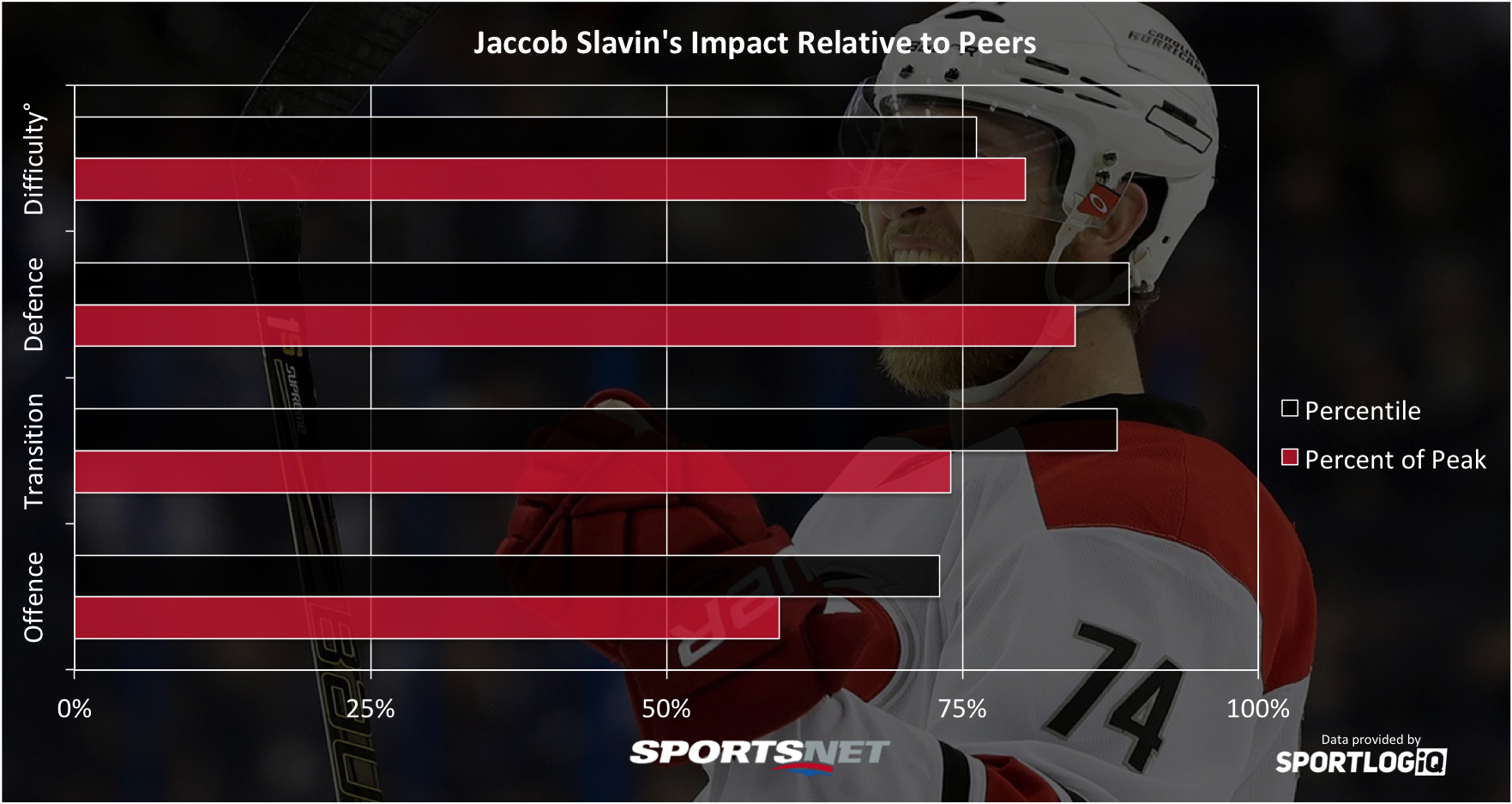
The average NHL consumer has started to really pick up on Slavin the past couple years, as he’s emerged as a dominant player for the Hurricanes despite not moving the needle a ton offensively. He’s not bad on the attack — he’s a far above average playmaker and gets involved with the cycle — but a lot of his impact is indirect.
It’s harder to get noticed playing like that, but Slavin has built himself a reputation as someone who’s difficult to play against because of his ability to strip opponents of possession, win puck battles, and quickly move the puck out of the defensive zone.
He’s one of the most aggressive checkers in the NHL without the puck, always harassing puck carriers, but he only takes about five minor penalties a season. How much more frustrating can it get than to play against someone who consistently gets in your face and cleanly takes the puck off you? He doesn’t have to cheat because he’s just better.
23. Ryan Suter
Difficulty adjustment: +7.28%
Offence: 12.56/25 | Transition: 26.78/40 | Defence: 19.16/35
Total: 58.50/100
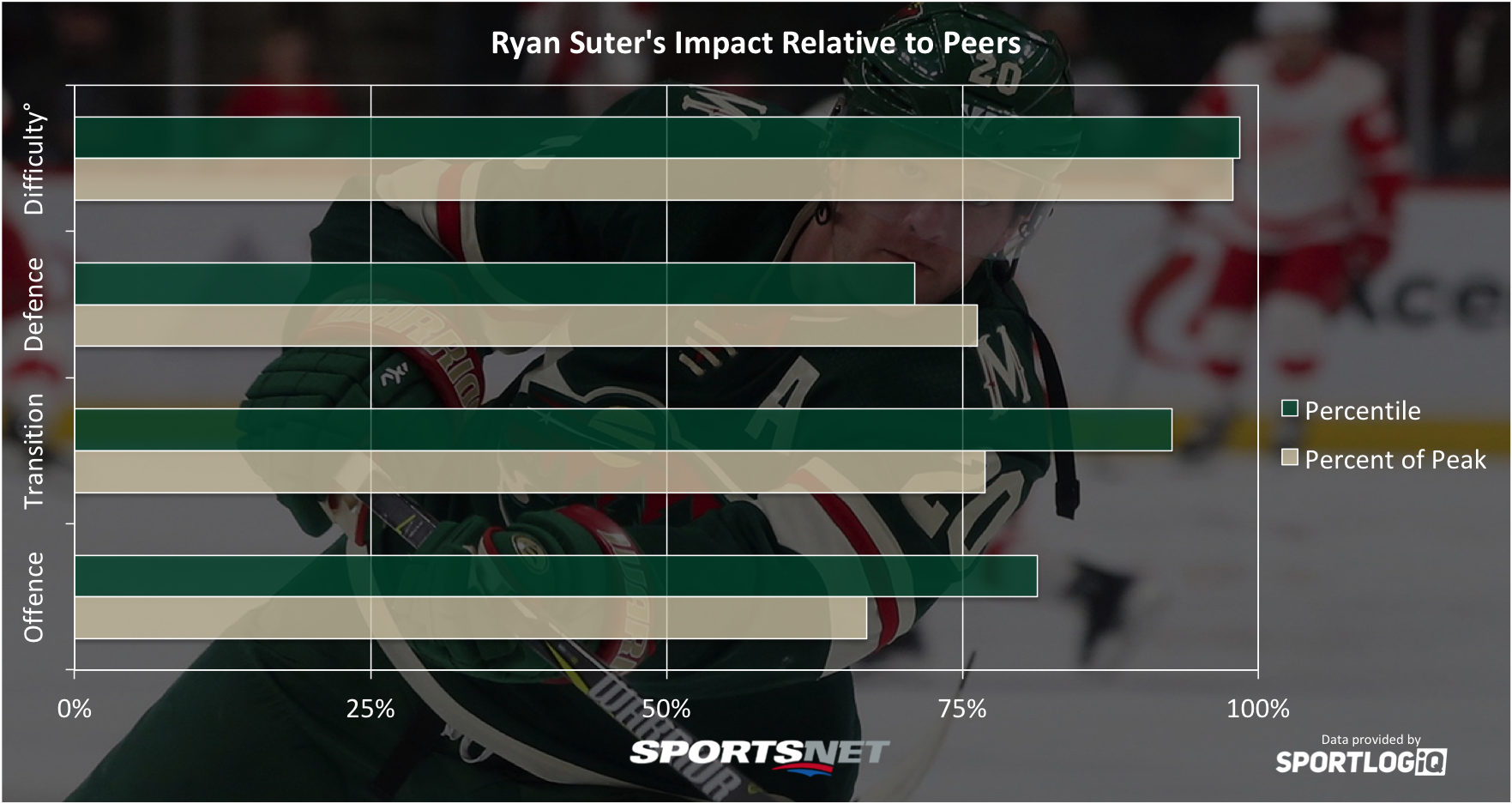
Every year I wonder if Suter can continue to take the heavy onslaught of minutes he puts on his shoulders, and honestly he would likely look like a much better player on the surface if he played 22 or 23 minutes per night instead of nearly 27. But he keeps handling brutal minutes and hasn’t declined much yet at age 33.
One of the reasons Suter is able to handle so many minutes is that he dictates the pace of play with his passing without forcing the issue much positionally — he isn’t an aggressive pincher or puck carrier despite having a smooth skating stride. Instead, Suter uses his feet to find clear passing lanes that provide him with an opportunity for high percentage passes that lead to few turnovers.
22. Jared Spurgeon
Difficulty adjustment: +4.21%
Offence: 12.81/25 | Transition: 26.05/40 | Defence: 19.71/35
Total: 58.57/100
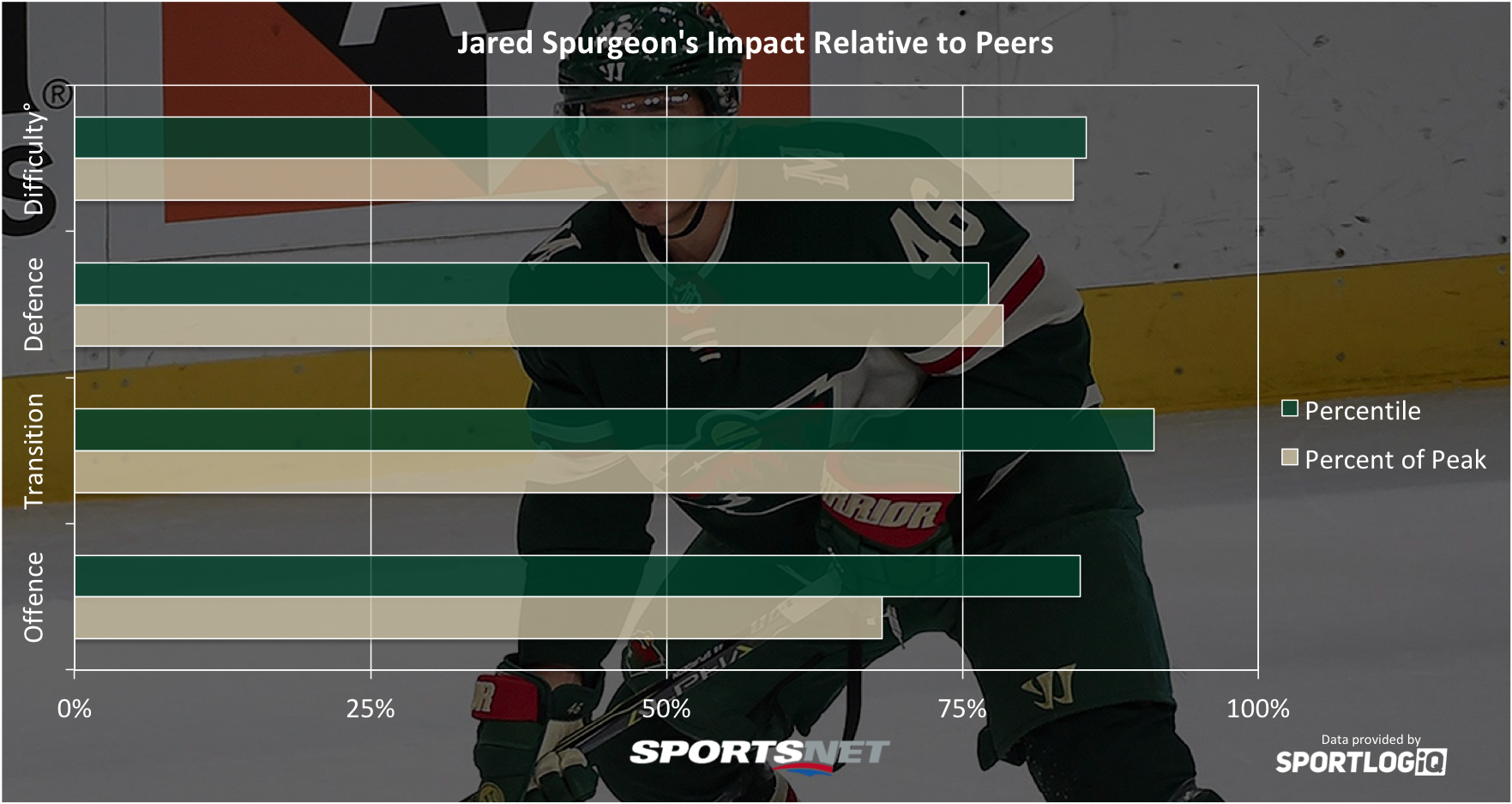
The overall impacts are so similar that you may as well call Spurgeon Lil’ Suter, but similar impacts don’t mean similar playing styles. Spurgeon is much more of a shooter than Suter and involves himself more directly in Minnesota’s offensive attacks by pinching more aggressively and being more active in the cycle.
In transition, Spurgeon isn’t as strong as Suter on zone exits, but in the neutral zone he’s brilliant and puts tons of passes right on the tape of teammates in stride, setting them up to take the offensive zone with control. Spurgeon’s biggest weakness is battling for the puck, as he’s fairly easily shaken off by big forwards. He makes up for this by being a spectacular neutral zone defender who rarely allows controlled entries against.
21. Morgan Rielly
Difficulty adjustment: +4.78%
Offence: 13.81/25 | Transition: 24.62/40 | Defence: 20.18/35
Total: 58.60/100

After a breakout defensive season in 2016-17, Rielly had a breakout offensive season last year, quarterbacking the most dangerous power play unit in the business. It was a little unexpected considering his fairly mediocre power play numbers before last year, but he has made great strides by making smart passes. You can tell when you watch Rielly that it’s always in the back of his mind to get the puck to dangerous areas.
Rielly’s play at both blue lines as a puck-rushing defenceman are the keys to his transition game. He can make some great passes in the neutral zone, but like most of the Leafs last year he struggled with defensive zone passes. Defensively, he uses his high-end skating ability to recover loose pucks before opponents can get to them, and he has massively improved his puck battling, where he is now in the top third of the league. Rielly has also become a guaranteed zone clearance option when he gets the puck on the penalty kill, leading to far fewer shots and scoring chances against while he’s on the ice.








